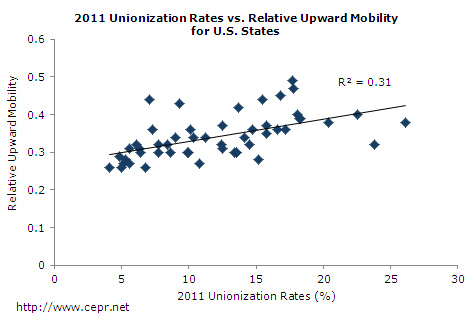June 05, 2012
In a recent post at The Atlantic Cities blog, sociologist Richard Florida provides an interesting analysis of some of the findings of a new study by the Pew Center on the States on economic mobility in the United States. Florida shows that, across the 50 states, there is a positive correlation between the degree of residents’ upward mobility and state: median household income; high school graduation rates; public education spending per pupil; and openness to immigrant and LGBTQ communities. His results help to expand the view of the sort of institutional and cultural contexts that support –or are at least associated with– high economic mobility.
On the other hand, Florida also demonstrates that states with a higher share of their labor force in what he defines as “working class professions” have lower rates of upward mobility. But, his analysis overlooks the role of the most important working class institution: labor unions. The figure below uses the same Pew data analyzed by Florida to compare upward mobility across states with different levels of unionization. The graph shows a strong, positive relationship between the share of a state’s workforce that is unionized and the Pew measure of upward mobility. The union data in the graph refer to 2011, but this is a long-standing relationship and a similar pattern holds for 1983, too (the earliest year for which comparable data are available).







